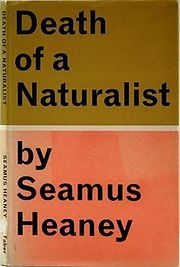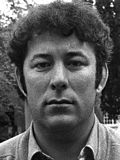- Death of a Naturalist
-
Death of a Naturalist 
1st EditionAuthor(s) Seamus Heaney Language English Publisher Faber and Faber Publication date 1966 Media type Print Pages 58 pp ISBN 0-571-06665-8 OCLC Number 4686783 Death of a Naturalist (1966) is a collection of poems written by Irish Nobel winner Seamus Heaney. The collection was Heaney's second major published volume, and includes ideas which he had presented at meetings of The Belfast Group. It won the Cholmondeley Award, the Gregory Award, the Somerset Maugham Award, and the Geoffrey Faber Memorial Prize.
The work consists of 34 short poems and is largely concerned with childhood experiences and the formulation of adult identities, family relationships, and rural life. The collection begins with one of Heaney's best-known poems, "Digging", and includes the acclaimed "Death of a Naturalist" and "Mid-Term Break".
Contents
Poems
From Mid-term break
Wearing a poppy bruise on the left temple,
He lay in the four foot box as in a cot.
No gaudy scars, the bumper knocked him clear.
A four foot box, a foot for every year.
“”from "Mid-term break",
Death of a Naturalist (1966)"Death of a Naturalist," the collection's second poem, details the exploits of a young boy collecting frogspawn from a flax-dam. The narrator remembers everything he saw and felt at those times. He then remembers his teacher telling him all about frogs in a section that speaks volumes about childhood innocence. Finally, we hear about a trip to the flax-dam that went wrong. He feels threatened by the frogs and flees. His interest in nature has gone - this is the death of a "naturalist" suggested in the poem's title. The poem makes extensive use of onomatopoeia and a simile that compares the behaviour of the amphibians to warfare ("Some sat poised like mud grenades") amongst other techniques.
"Mid-Term Break" is a reflection on the death of Heaney's four-year-old brother, Christopher, while Heaney was at school.[1] He describes his parents' different ways of displaying grief, visitors paying their respects, and his encounter of his brother's corpse in its coffin the next morning.[1] The poem focuses on concrete particulars of Heaney's experience and "captures a boy’s unfolding consciousness of death."[1] The final line ("A four foot box, a foot for every year.") emphasizes death's finality.[1]
Further reading
- Allen, Michael, Ed. Seamus Heaney. Basingstoke : Macmillan, 1997.
- Cañadas, Ivan. “Working Nation(s): Seamus Heaney’s ‘Digging’ and the Work Ethic in Post-Colonial and Minority Writing.” EESE: Erfurt Electronic Studies in English (2010). [2]
- Corcoran, Neil. The Poetry of Seamus Heaney: a Critical Study. London: Faber, 1998.
- Foster, John Wilson. The Achievement of Seamus Heaney. Dublin: The Lilliput Press, 1995.
- Garratt, Robert F., Ed., Critical Essays on Seamus Heaney. New York: G.K. Hall, 1995.
- Heaney, Seamus. New Selected Poems, 1966-1987. London & Boston: Faber and Faber, 1990.
- Heaney, Seamus. Seamus Heaney in Conversation with Karl Miller. London: Between The Lines, 2000.
- Mathias, Roland. “Death of a Naturalist”, in: The Art of Seamus Heaney, Ed. Tony Curtis, 3rd Edn. Bridgen, Wales: Seren Books, 1994. pp. 11-25.
- Morrison, Blake. Seamus Heaney. London & New York: Methuen, 1982.
- Murphy, Andrew. Seamus Heaney. Plymouth: Northcote House / British Council, 1996.
See also
- Seamus Heaney
- Seamus Heaney Collected Poems album
References
Seamus Heaney Poetry Death of a Naturalist · Door into the Dark · Wintering Out · Stations · North · Field Work · Station Island · The Haw Lantern · Seeing Things · The Spirit Level · Electric Light · District and Circle · Human Chain · New Selected Poems 1966-1987
Plays The Cure at Troy · The Burial at Thebes
Translations Recordings The Poet and The Piper · Collected Poems
Category:Works by Seamus HeaneyCategories:- Irish books
- 1966 books
- Poetry collections
- Irish poetry
- Poetry by Seamus Heaney
Wikimedia Foundation. 2010.

